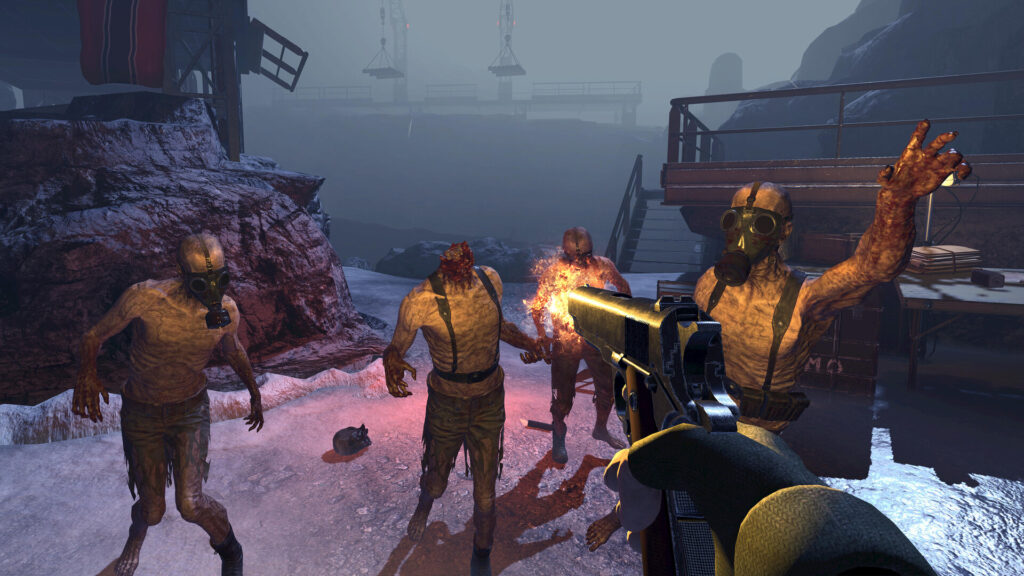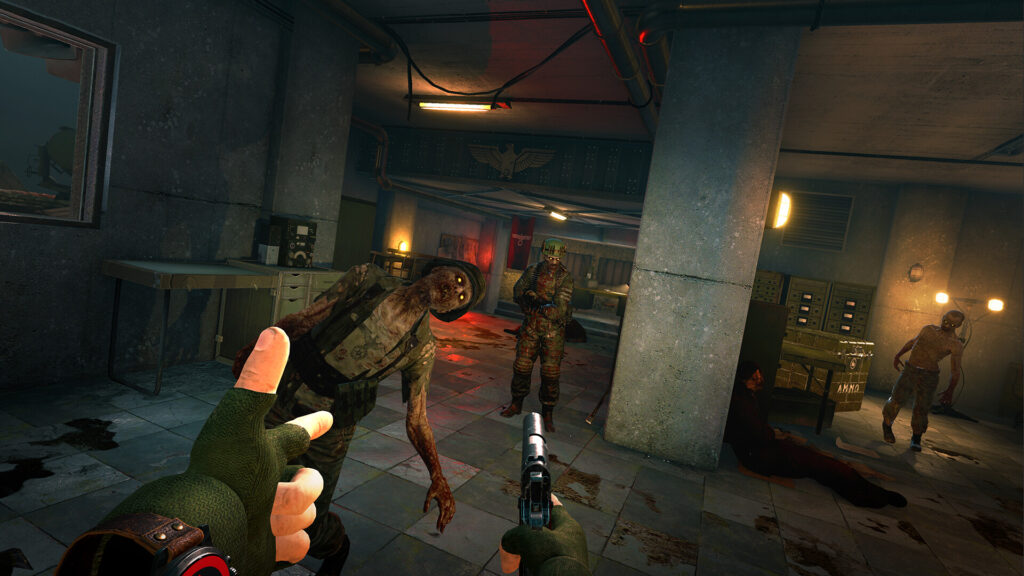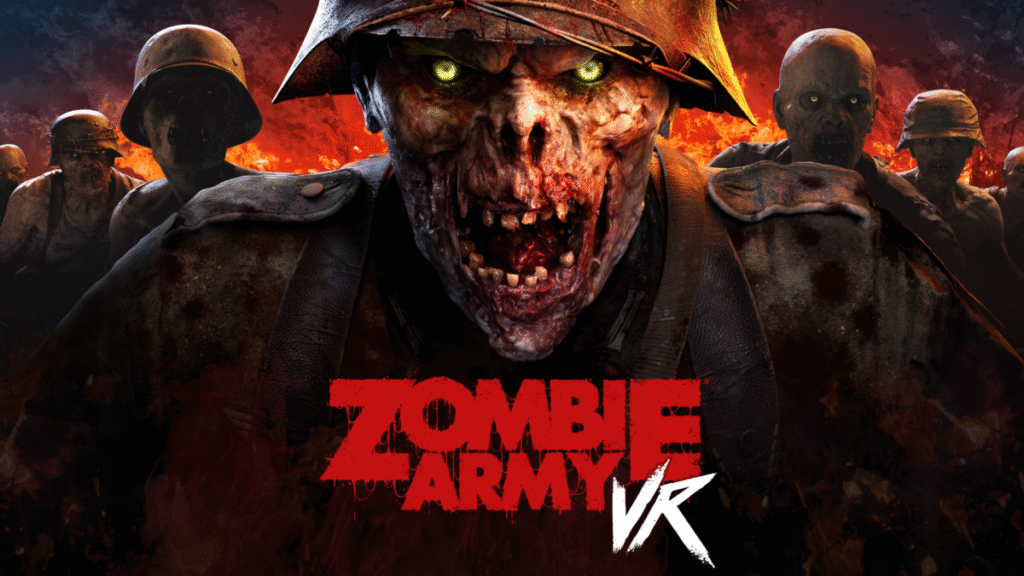Zombie Army VR drops you right into the gore-slicked trenches of post-apocalyptic WWII Europe as a Deadhunter, a skull-crushing, sniper-slinging elite enforcer sweeping up what’s left of Zombie Hitler’s undead army. Developed by Rebellion and Xtended Realities, this VR spinoff of the Zombie Army series is less tactical shooter and more arcade meat grinder.
This isn’t The Walking Dead: Saints & Sinners. You’re not scavenging for food. You’re popping heads like balloons, racking up score multipliers, and juggling grenades with style. It’s loud, silly, gory, and—if played with a friend—surprisingly fun. Just don’t expect depth or variety.

🧠 Shoot, Score, Survive
At its core, Zombie Army VR is a five-hour, wave-based rail-light shooter. You push through linear levels—abandoned bunkers, trench systems, ruined villages—shooting dozens of zombie types with a three-gun loadout and a backpack full of explosives.
You’ve got a sniper, a secondary (usually an SMG or shotgun), and a sidearm. Guns feel good—chunky, responsive, and satisfying to reload. Add in the return of Sniper Elite’s slow-mo X-ray kill cams, and you’ve got some genuinely visceral payoffs for precision shots.
Grenades are a highlight: healing lures, zombie-attracting mines, pipe bombs—they’re not just tools, they’re your panic buttons. Throw one at the right time and you clear a room. Miss it, and you’re meat.
🔫 Punchy, But Not Perfect
What Zombie Army VR nails is moment-to-moment combat. Weapons have punch, especially in VR. Blowing limbs off with a sniper, dual-wielding pistols, chucking bricks—it all feels tactile and fun.
Where it falters is variety. The early missions throw a decent mix at you: runners, snipers, shielded heavies, exploding suiciders. But by the midpoint, you’ve seen everything. Levels start repeating in reverse, enemy spawns become predictable, and gun unlocks dry up.
The absence of a pump-action shotgun? Feels like a crime. So does the inability to use pistols with both hands—immersion takes a hit when your powerful sidearm can’t be stabilized.
🎮 VR Design: Mostly Smart, Occasionally Sloppy
Zombie Army VR is built for VR, not ported—and it shows. Reload mechanics are tactile. Belt/pouch adjustment for seated or standing players is a win. PSVR2 features like adaptive triggers and headset haptics are well utilized.
But immersion stumbles. Sniper scopes black out your entire view. Inventory is a flat UI instead of a physics-based backpack. Tracer rounds can’t be toggled off. And for a 2025 release, the lack of two-handed pistol support is just outdated.
The satchel system works, but it’s more functional than immersive. It gets the job done, but it won’t make you feel like you’re in the world—it reminds you you’re playing in it.

👥 Co-op Is the Star—Solo, Not So Much
Let’s be clear: Zombie Army VR is meant to be played with a friend. The game supports two-player online co-op, and it’s here that it really shines. Reviving each other, sharing resources, tag-teaming waves—it’s chaotic fun.
Solo is doable—and even decently balanced—but repetition sets in faster. Without a buddy to laugh off janky moments or sync up sniper shots, the cracks in the gameplay loop become more obvious.
Also, there’s no crossplay. And no in-game voice chat on PSVR2. Combine that with losing checkpoint progress when jumping into co-op, and it’s clear some multiplayer features still need polish.
🧠 Replayability & Progression
There’s light progression here: score multipliers, weapon upgrade kits, collectibles, and leaderboard chasing. You can trick out your sniper for health-on-headshot or give your SMG bigger mags. It’s enough to make loadouts feel personal—briefly.
But once you’ve beaten the campaign, the reasons to replay are slim. No challenge modes. No modifiers. Just harder difficulty and scoreboards.
🎨 Visuals, Sound, and Performance
The presentation is strong. On Valve Index, it’s sharp, with consistent framerate and solid lighting. PSVR2 handles things admirably too, minus some minor ghosting and aliasing. Quest 3 is the weakest of the bunch, with flat lighting and low-res textures—but still very playable.
The atmosphere leans into pulpy WWII horror: blood-drenched bunkers, occult symbols, and grotesque zombie models. Guns sound satisfying. Explosions rattle your headset. Rebellion’s always been good at audio-visual feedback, and it’s no different here.

✅ What Works
🔹 Satisfying Arcade Gunplay
Explosions, sniper cams, and visceral reloads keep the loop fun.
🔹 Seamless Co-op Integration
Two-player co-op massively improves replay value and pacing.
🔹 Weapon Variety and Upgrades
Tons of WWII-style guns, satisfying unlocks, and upgrades that matter.
🔹 Thematic Visuals and Atmosphere
Pulpy zombie-war aesthetic hits the right B-movie tone.
🔹 Solid Comfort Options
Great accessibility and physicality support for a wide range of VR setups.
❌ What Doesn’t
🔻 Repetition Sets in Fast
Level design, enemy types, and mission objectives get stale after a few hours.
🔻 Solo Play Feels Flat
Playable, but lacks the intensity and fun of co-op.
🔻 No Crossplay or Four-Player Mode
Two-player only, and you’re locked to your platform.
🔻 No Dual-Handed Pistols
Inexcusable in 2025 for immersion.
🔻 Immersion-Breaking UI Elements
Sniper FOV blackouts, auto-magnet reloads, flat inventory UI—functional, but not immersive.
🧪 Should You Play It?
Yes—if you’re craving that arcade zombie shooter feel in VR, especially with a friend. It delivers action, score-chasing, and plenty of zombie limbs flying through the air.
No—if you’re after depth, narrative, or a horror-driven VR experience.
💸 Should You Buy It?
At $30? If you’re planning to play co-op: yes, absolutely. If you’re solo-only, maybe wait for a sale. The value’s there—just not a lot of staying power.
Zombie Army VR: It’s dumb, fun, and soaked in blood. Zombie Army VR doesn’t reinvent the genre, but it does deliver five hours of solid undead-blasting chaos. – Obsidian


